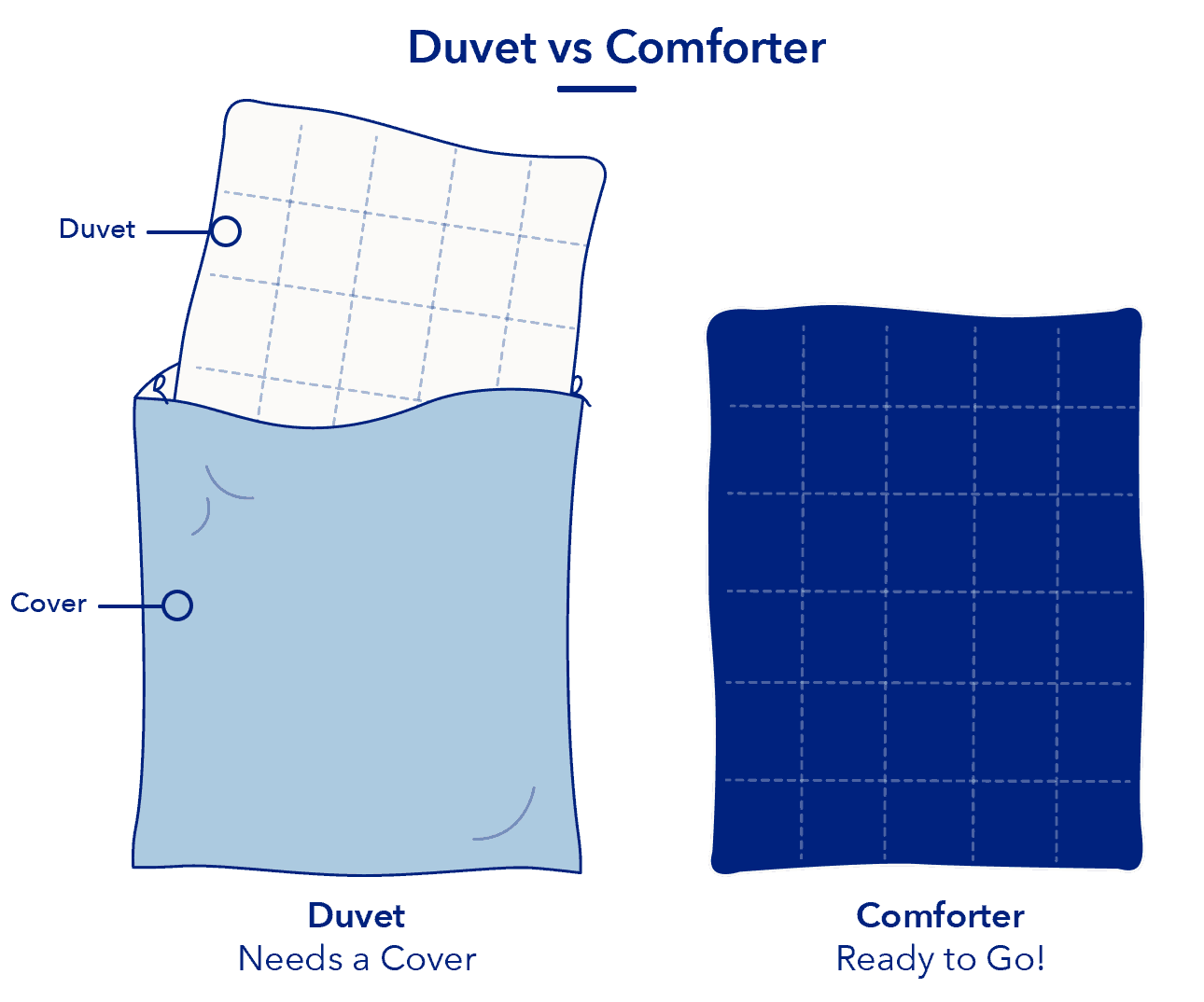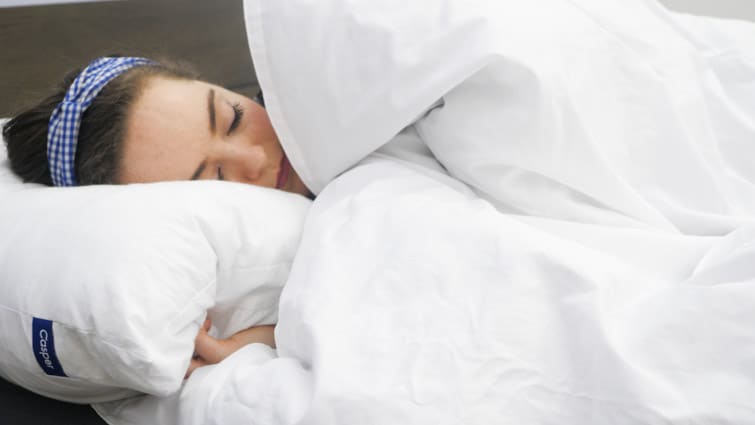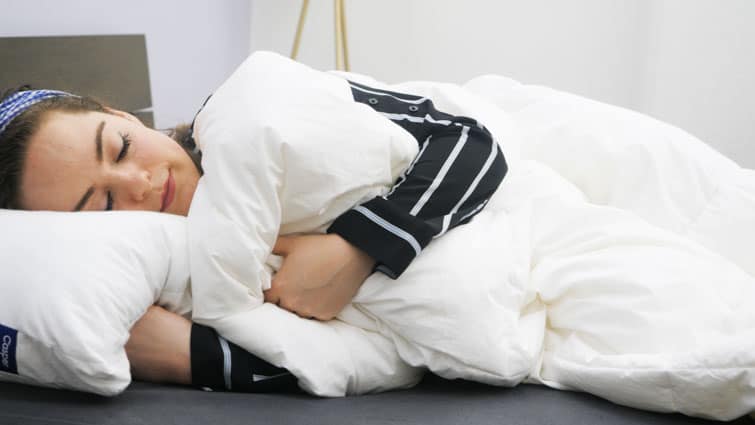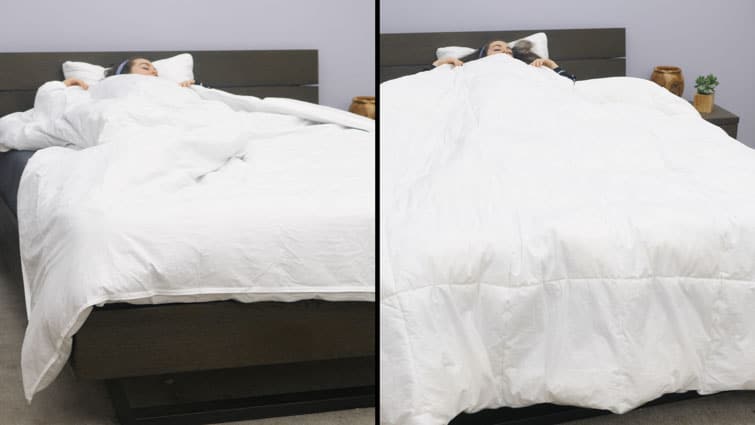If you’re reading this, it’s probably because you don’t know the difference between a duvet and a comforter. Which one is fluffier? Which one is easier to clean? Are they even really that different? Well, you’ve come to the right place, because Sleepopolis is here to fill you in on everything you need to know about these two bedding essentials, and help you find out which is best for you.
Now, some of you may have already read our Casper mattress review as well as our review of the Casper pillow but, for this demonstration, I’ll be using Casper’s Humidity Fighting Duvet and Weightless Duvet Cover. This way, you can get an up-close look at the differences (and similarities) of comforters and duvets. Okay, let’s get into it!
What’s The Difference Between a Comforter and a Duvet?
Let me start by saying that if you’ve ever confused a duvet for a comforter, I promise you’re not alone. They actually have a lot in common! Both duvets and comforters:
- Fluffy & Cozy — Both duvets and comforters are super plush, fluffy quilts that keep you cozy at night.
- Internal Fill — They both typically come filled with down, feathers, or synthetic fibers.
- All Seasons — Both duvets and comforters can be enjoyed year-round!
In addition to these commonalities, there are some less noticeable differences that can vary from product to product:
- Fill Power — Typically, duvets feature a higher fill power, which means they’re often fluffier than comforters.
- Sewn-through Pattern — Comforters always feature a sewn-through quilted pattern to ensure an even distribution of internal fill. Duvets usually do too, but sometimes they look more like a loose, fluffy bag.
- Size — Though comforters are usually less fluffy than duvets, they are often larger in size, offering more hangover on the mattress.
FAQ
Q: What does fill power mean? A: “Fill power” refers to the measure of the loft of a down or down alternative product. The greater the fill power, the more insulating and fluffy the product will be!Now, remember folks: the differences listed above do vary among bedding brands, so don’t be surprised if you find some exceptions to those rules. But there is one constant, key way to tell the difference between a duvet a comforter — a duvet is designed to go inside a duvet cover, and a comforter is just one piece of bedding that’s ready to go right out of the bag.

Seems like a pretty easy way to identify which is which, right? Well, just because you can spot the difference between the two doesn’t necessarily mean you know which one is best suited to your sleep needs. That said, let’s dive deeper into the details of what makes each accessory special (and what might be a dealbreaker!).
Duvets VS Comforters: Which One Should I Buy?
Both duvets and comforters come with their own unique set of perks, as well as some potential pitfalls. So, let’s compare them side by side so you can decide which one is the best fit for you.
Duvets
Essentially, the duvet is the insert that goes into the duvet cover, and the cover is like a pillowcase for your duvet.

Now, the practical purpose of the cover is that it protects your duvet, keeping it clean, pristine, and safely tucked away. But let’s take a closer look at all the advantages that come with using a duvet:
- Switch Up Style — My favorite thing about the duvet cover is that it offers you the chance to experiment with style. If you want to spruce up the look of your bedroom, changing your duvet cover is a quick and easy way to do that. And because duvet covers are easily removed and replaced, nothing is stopping you from having many different covers all bearing different designs and materials. When you’re in the mood to play with your bedroom decor, just swap out your duvet cover!
- “Euorpean-Style” Sleeping — Speaking of switching things up, did you know it’s quite common for duvet-users to sleep without a top sheet? It’s called “sleeping European style,” and many bedding brands substitute top sheets for duvet covers in sheet sets. Don’t worry, the duvet cover is often just as soft as your top sheet, and comes in a wide range of fabrics and weaves. So, if your top sheet usually gets kicked off the bed or tangled between your legs, take it out of the mix with some European-style sleeping.
- Easy Wash Care — If you’re really not into the idea of washing a bulky piece of bedding, the duvet might be for you. All you have to do is remove the duvet’s cover, and throw it in the washing machine with the rest of your sheets. Comforters, on the other hand, are not quite as simple to care for (but we’ll get into that later!).
FAQ
Q: Should a duvet be smaller than a comforter? A: Typically, comforters are larger than duvets, offering more hangover on your mattress. Meanwhile, duvets are usually much fluffier!Okay, so we know that duvets are easy to clean, allow sleepers to frequently switch up bedroom decor, and make a great substitute for a top sheet… But what’s not to love about a duvet? Well, in my opinion, there is one main downfall of the duvet:
- Complex & Cumbersome — In order to get your duvet inside its cover, you have to reach inside the cover, two duvet corners in each hand, and make sure that the duvet is evenly distributed. When it’s fully inside the cover, you still have to do quite a bit of shaking and fluffing in order to achieve an even loft. That said, I strongly suggest you look for duvet covers with internal clasps, like Casper’s duvet covers have. If you get a duvet that does not offer those clasps, it’s only a matter of time before it’s balled up into one pocket of its cover.

Now that we’ve taken a close look at the ins and outs of the duvet, let’s see how the comforter compares.
Comforters
The comforter is one piece of bedding that’s ready to use right out of the packaging, no cover required.

But even though comforters don’t come with covers, they are decorative in their own right, and come with some unique advantages:
- Shopping Ease — Comforters often come as part of a “bed-in-a-bag” ensemble, which might appeal to folks whose idea of a good time is not shopping for bedding that matches. With bed-in-a-bag bundles, your comforter comes complete with color coordinating pillowcases and sheets. Duvets and duvet covers, on the other hand, are usually separate purchases. So, folks who aren’t enthused about picking that perfectly matching set of pillowcases and sheets have the option to just knock it all out in one purchase.
- Simplicity — Like I said, comforters are ready to use as soon as you take it out of its packaging. No shuffling with covers or outer layers of any kind is required, as the comforter is one piece of bedding. Without the cover, the comforter is harder to clean, but it’s also much easier to maneuver, and you never have to worry about an uneven distribution of fill.
- Layered Look — If you like your bed to have a layered look, the comforter might be best for you. Comforters look great on top of sheets, and stacked beneath additional blankets and throws. Because comforters feature a sewn-through pattern and are usually less fluffy than duvets, your extra blankets should lay flat on the comforter, and won’t appear lumpy as can happen with the duvet.
FAQ
Q: Will a duvet cover fit over a comforter? A: While duvet covers are technically designed to complement duvets, there is no rule against covering your comforter with a duvet cover! The cover serves as a protective layer for your bedding; just make sure it fits snugly.Now, before you decide that the comforter is the best choice for you, let’s talk about wash care. When it comes to comforters, I think the primary pitfall is that they are harder to clean:
- Caring for Comforters — Because comforters don’t have the protective outer layer that duvets have, you should wash your comforter once a month, and spot clean as needed. Of course, a comforter is much larger than a duvet cover, so it takes longer to wash and dry, and should be washed by itself. Care instructions vary, so always check the wash care tag on your comforter before you start your laundry. But some sleepers may find that their duvet lasts longer than their comforter, as the duvet itself does not need frequent washing (only the duvet cover).
Anything Else I Should Know?

Now that we’ve taken a look at the differences between comforters and duvets, you might now be wondering, “What about price? Which one is more durable? Which is more popular?” Well, the simple answer is that everything varies from brand to brand. That said, there are a few generalities that might help guide you in your search:
- Pricing — While duvets and comforters tend to hover around the same price point, it’s worth noting that materials matter. A duvet or comforter that’s filled with down is typically going to be pricier than those filled with synthetic fibers. Additionally, special textile technology (like the added layer of merino wool in Casper’s duvet) often contributes to a higher cost. It’s also worth noting that duvets do not always come with duvet covers; they are often two separate purchases. So, when all is said and done, you might find that the comforter is less expensive.
- Durability — Some might argue that the duvet gives you more bang for your buck. The duvet cover is easily replaceable, so you can switch up the look of your bedding without having to sink money into a brand new duvet. With comforters, you’d have to buy a new one. Meanwhile, duvet cover offers a layer of protection between your duvet and the outside world, which helps maintain the integrity of your duvet.
- Availability — Like with Casper, most bedding brands offer both comforters, duvets, and duvet covers. In fact, an increasing number of bedding brands are including duvet covers with their sheet sets. That said, the availability of these items frequently depends upon where in the world you are! For example, comforters are quite popular in the U.S.A, but many European and Asian countries prefer the duvet.
Final Thoughts
Well, there you have it, sleepers. Now you know all about the differences between duvets and comforters, and you’re fully equipped to decide which is the right fit for you. But remember: most bedding brands do offer trial periods, so if you want to test either of these sleep accessories before you commit, you probably can! In the meantime, allow this Sleepopolis review to be your guide.